Abstract
During the last two decades, an increasing number of epidemiologic studies have found cohorts of workers to be at high risk of work-related chronic diseases, especially cancers. These studies frequently have led to the broad recognition of occupational hazards and eventually to the prevention of exposures to such hazards. Generally, however, the individual cohort members found to be at high risk have not been notified of study results, and programs of medical intervention or of palliative services directed at these individual workers have not been developed. Recently, the issue of whether or not workers have a right to be notified more directly about known health hazards to which they may have been exposed has emerged as a major, unresolved question in public health policy. Issues of concern include the criteria that should guide notifications; whom, when, and how to notify; and who should pay for notification and follow-up services. This commentary discusses the scientific, ethical, economic, and institutional aspects of worker notification, and describes three new demonstration projects that have provided notification and intervention for workers at high risk of bladder, colon, and lung cancer.
Full text
PDF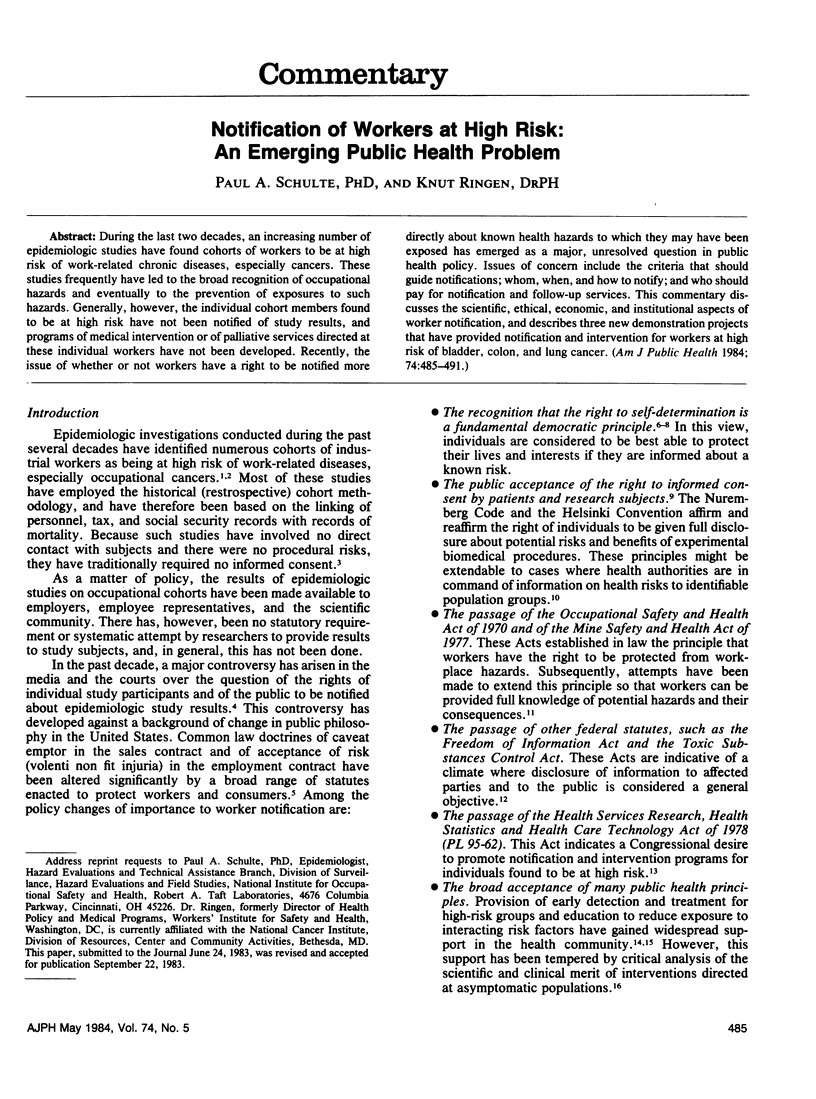
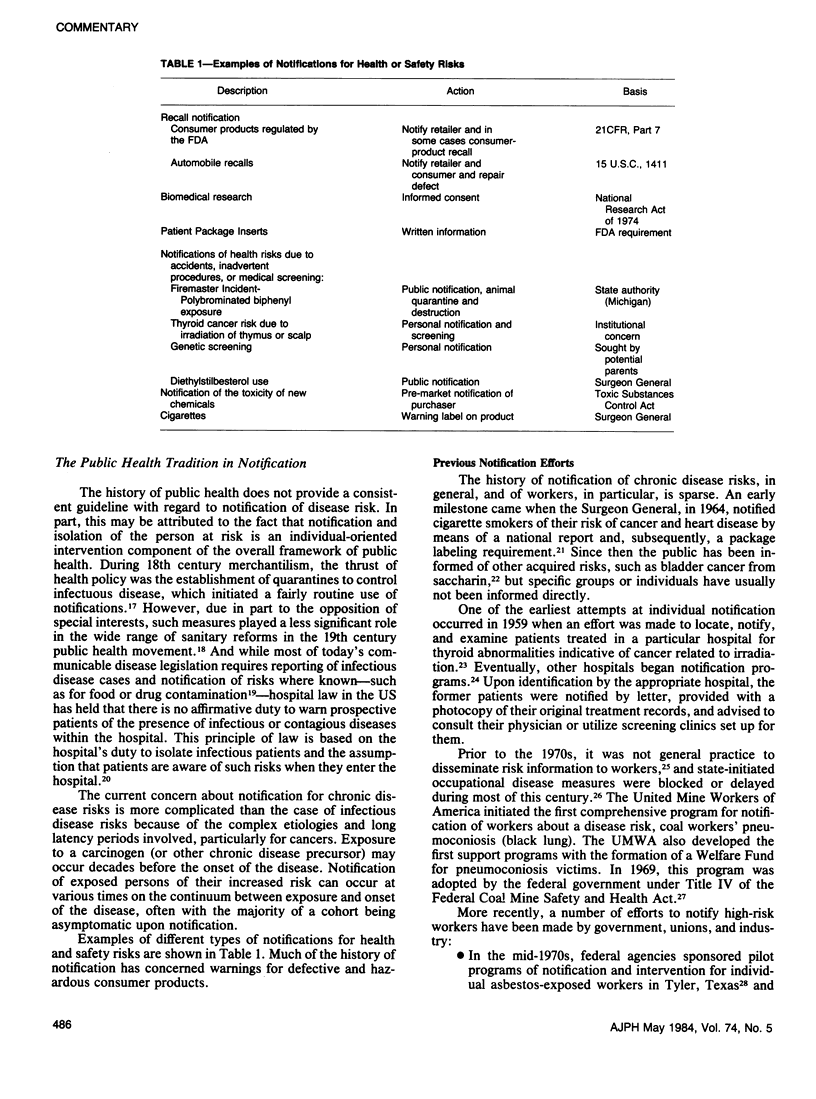
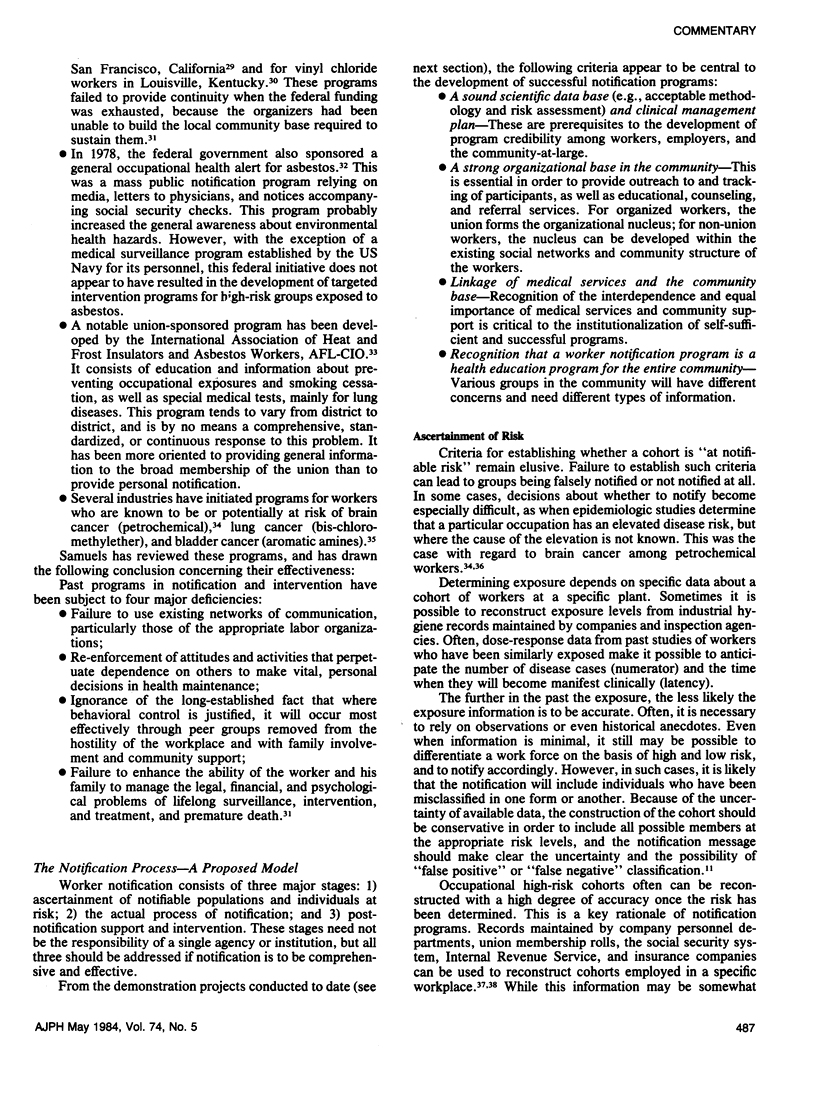
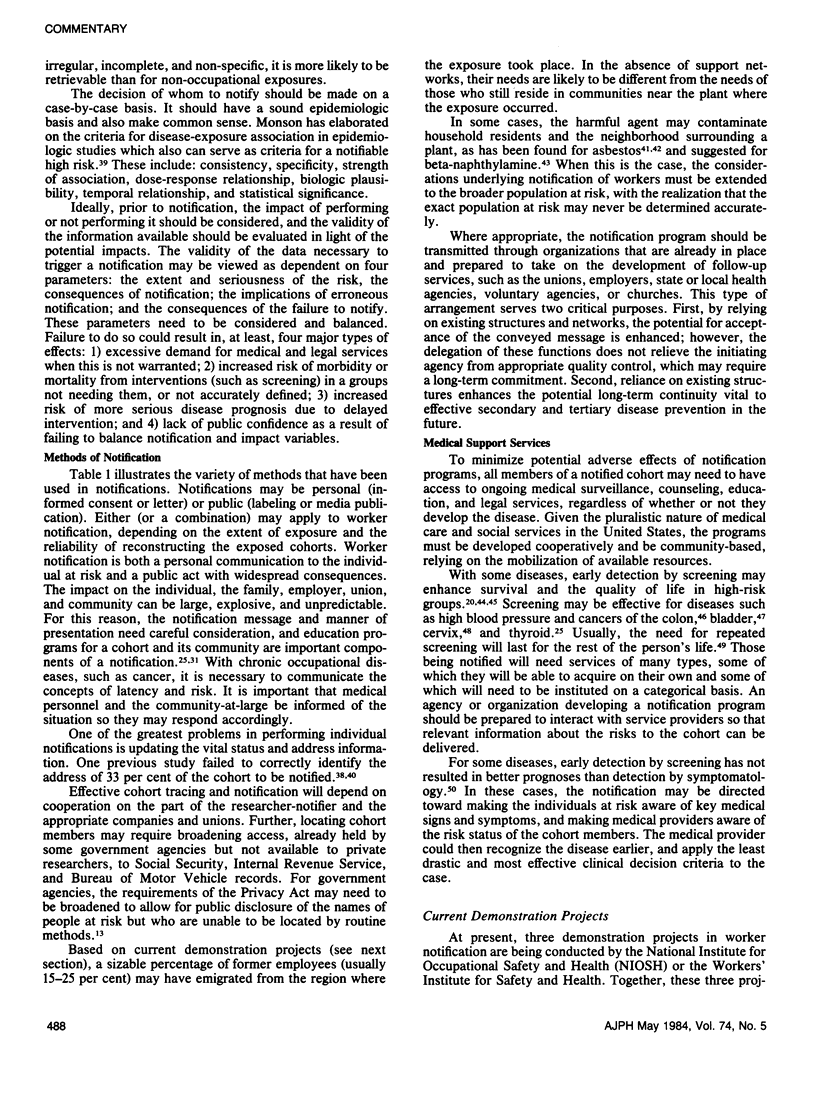
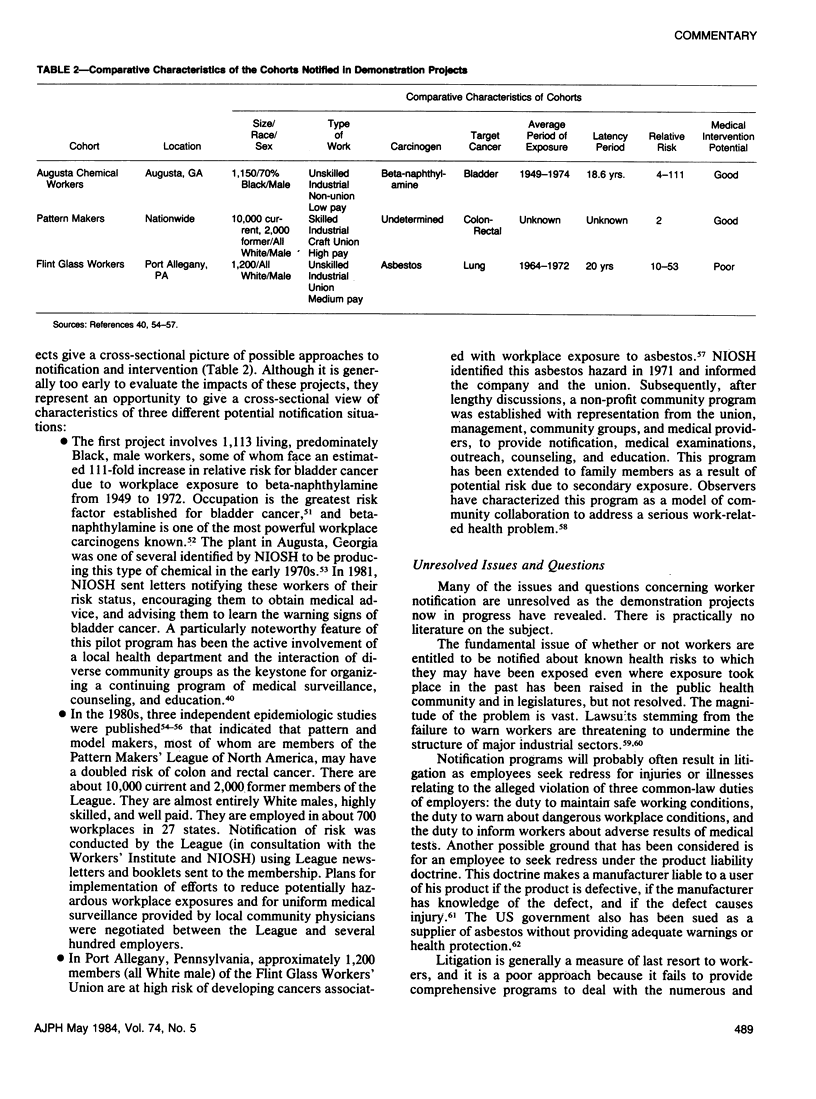
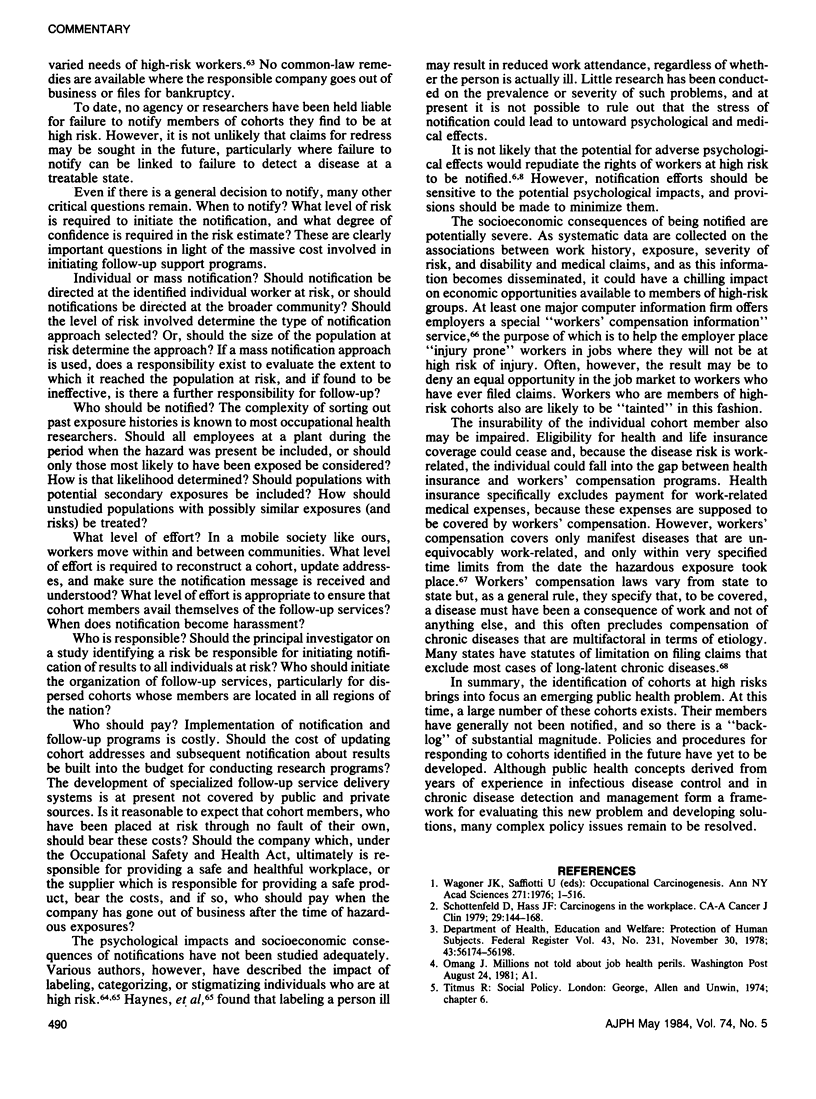
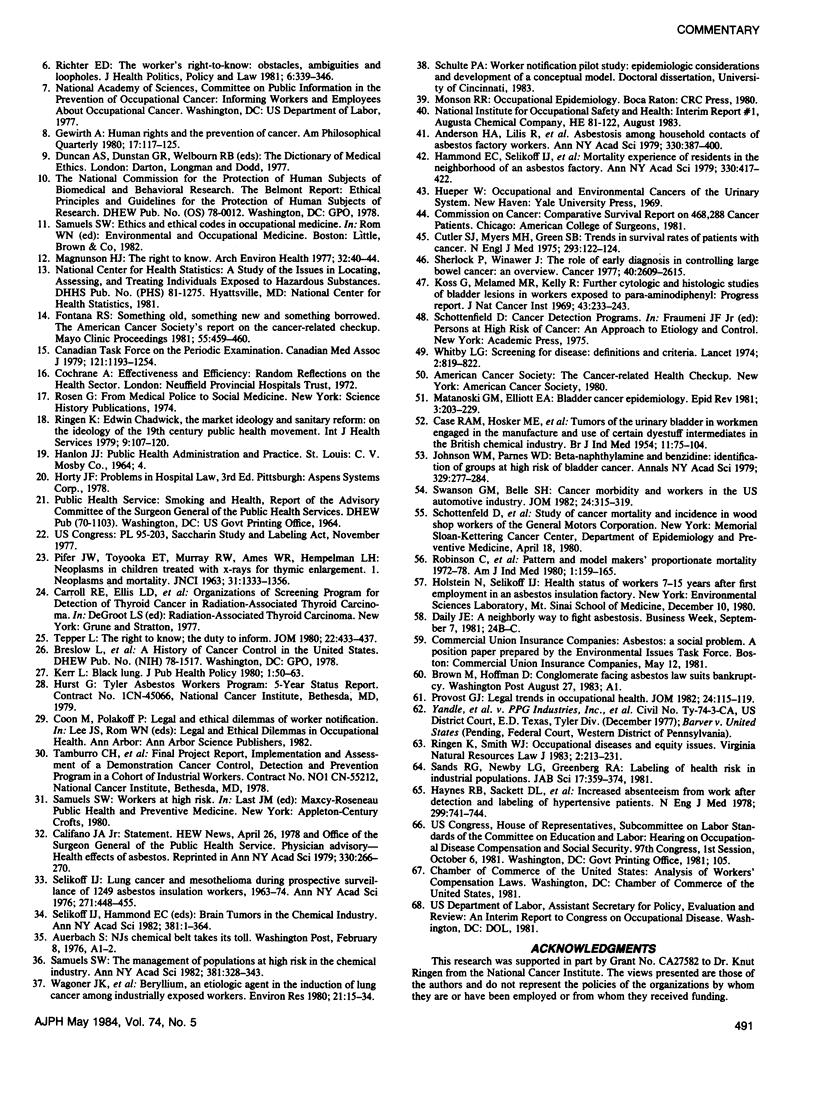
Selected References
These references are in PubMed. This may not be the complete list of references from this article.
- Anderson H. A., Lilis R., Daum S. M., Selikoff I. J. Asbestosis among household contacts of asbestos factory workers. Ann N Y Acad Sci. 1979;330:387–399. doi: 10.1111/j.1749-6632.1979.tb18741.x. [DOI] [PubMed] [Google Scholar]
- CASE R. A., HOSKER M. E., McDONALD D. B., PEARSON J. T. Tumours of the urinary bladder in workmen engaged in the manufacture and use of certain dyestuff intermediates in the British chemical industry. I. The role of aniline, benzidine, alpha-naphthylamine, and beta-naphthylamine. Br J Ind Med. 1954 Apr;11(2):75–104. doi: 10.1136/oem.11.2.75. [DOI] [PMC free article] [PubMed] [Google Scholar]
- Cutler S. J., Myers M. H., Green S. B. Trends in survival rates of patients with cancer. N Engl J Med. 1975 Jul 17;293(3):122–124. doi: 10.1056/NEJM197507172930305. [DOI] [PubMed] [Google Scholar]
- Fontana R. S. Something old, something new, and something borrowed--the American Cancer Society's report on the cancer-related health checkup. Mayo Clin Proc. 1980 Jul;55(7):459–460. [PubMed] [Google Scholar]
- Gewirth Alan. Human rights and the prevention of cancer. Am Philos Q. 1980 Apr;17(2):117–125. [PubMed] [Google Scholar]
- Hammond E. C., Garfinkel L., Selikoff I. J., Nicholson W. J. Mortality experience of residents in the neighborhood of an asbestos factory. Ann N Y Acad Sci. 1979;330:417–422. doi: 10.1111/j.1749-6632.1979.tb18743.x. [DOI] [PubMed] [Google Scholar]
- Haynes R. B., Sackett D. L., Taylor D. W., Gibson E. S., Johnson A. L. Increased absenteeism from work after detection and labeling of hypertensive patients. N Engl J Med. 1978 Oct 5;299(14):741–744. doi: 10.1056/NEJM197810052991403. [DOI] [PubMed] [Google Scholar]
- Kerr L. E. Black lung. J Public Health Policy. 1980 Mar;1(1):50–63. [PubMed] [Google Scholar]
- Koss L. G., Melamed M. R., Kelly E. Further cytologic and histologic studies of bladder lesions in workers exposed to para-aminodiphenyl: progress report. J Natl Cancer Inst. 1969 Jul;43(1):233–243. [PubMed] [Google Scholar]
- Magnuson H. J. The right to know. Arch Environ Health. 1977 Jan-Feb;32(1):40–44. doi: 10.1080/00039896.1977.10667252. [DOI] [PubMed] [Google Scholar]
- Matanoski G. M., Elliott E. A. Bladder cancer epidemiology. Epidemiol Rev. 1981;3:203–229. doi: 10.1093/oxfordjournals.epirev.a036234. [DOI] [PubMed] [Google Scholar]
- PIFER J. W., TOYOOKA E. T., MURRAY R. W., AMES W. R., HEMPELMANN L. H. NEOPLASMS IN CHILDREN TREATED WITH X RAYS FOR THYMIC ENLARGEMENT. I. NEOPLASMS AND MORTALITY. J Natl Cancer Inst. 1963 Dec;31:1333–1356. [PubMed] [Google Scholar]
- Provost G. J. Legal trends in occupational health. J Occup Med. 1982 Feb;24(2):115–119. [PubMed] [Google Scholar]
- Richter E. D. The worker's right-to-know: obstacles, ambiguities and loopholes. J Health Polit Policy Law. 1981 Summer;6(2):339–346. doi: 10.1215/03616878-6-2-339. [DOI] [PubMed] [Google Scholar]
- Ringen K. Edwin Chadwick, the market ideology, and sanitary reform: on the nature of the 19th-century public health movement. Int J Health Serv. 1979;9(1):107–120. doi: 10.2190/LR4G-X2NK-9363-F1EC. [DOI] [PubMed] [Google Scholar]
- Robinson C., Waxweiler R. J., McCammon C. S. Pattern and model makers, proportionate mortality 1972-1978. Am J Ind Med. 1980;1(2):159–165. doi: 10.1002/ajim.4700010206. [DOI] [PubMed] [Google Scholar]
- Samuels S. W. The management of populations at high risk in the chemical industry. Ann N Y Acad Sci. 1982;381:328–343. doi: 10.1111/j.1749-6632.1982.tb50397.x. [DOI] [PubMed] [Google Scholar]
- Schottenfeld D., Haas J. F. Carcinogens in the workplace. CA Cancer J Clin. 1979 May-Jun;29(3):144–168. doi: 10.3322/canjclin.29.3.144. [DOI] [PubMed] [Google Scholar]
- Selikoff I. J. Lung cancer and mesothelioma during prospective surveillance of 1249 asbestos insulation workers, 1963-1974. Ann N Y Acad Sci. 1976;271:448–456. doi: 10.1111/j.1749-6632.1976.tb23146.x. [DOI] [PubMed] [Google Scholar]
- Sherlock P., Winawer S. J. The role of early diagnosis is controlling large bowel cancer. Cancer. 1977 Nov;40(5 Suppl):2609–2615. doi: 10.1002/1097-0142(197711)40:5+<2609::aid-cncr2820400933>3.0.co;2-u. [DOI] [PubMed] [Google Scholar]
- Swanson G. M., Belle S. H. Cancer morbidity among woodworkers in the U.S. automotive industry. J Occup Med. 1982 Apr;24(4):315–319. [PubMed] [Google Scholar]
- Tepper L. B. The right to know; the duty to inform. J Occup Med. 1980 Jul;22(7):433–437. [PubMed] [Google Scholar]
- Wagoner J. K., Infante P. F., Bayliss D. L. Beryllium: an etiologic agent in the induction of lung cancer, nonneoplastic respiratory disease, and heart disease among industrially exposed workers. Environ Res. 1980 Feb;21(1):15–34. doi: 10.1016/0013-9351(80)90004-3. [DOI] [PubMed] [Google Scholar]
- Whitby L. G. Screening for disease: Definitions and criteria. Lancet. 1974 Oct 5;2(7884):819–822. doi: 10.1016/s0140-6736(74)91082-4. [DOI] [PubMed] [Google Scholar]


